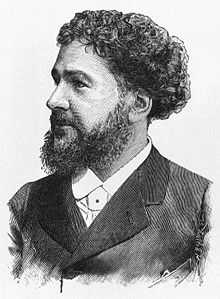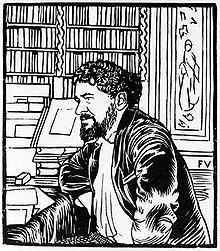Octave Uzanne

Louis Octave Uzanne (14 September 1851 – 31 October 1931), known as Octave Uzanne, was a 19th-century French bibliophile, non-fiction writer, publisher and journalist.
Biography
Born in Auxerre, of a bourgeois family, he came to Paris after his father's death. At first he studied at the upper-class Collège Rollin in Paris, then during the Franco-Prussian War of 1870–1871 was attached to a school at Richmond in England.[1] Continuing with law studies, he abandoned this line of work when he came into an inheritance in 1872. He became a regular visitor of the Bibliothèque de l'Arsenal, where he formed part of a group of followers of the former librarian Charles Nodier, together with journalist Charles Monselet, writer Loredan Larchey, and author and bibliophile Paul Lacroix. He also joined the Société des Amis des Livres, the first French bibliophilic association.[2]
At the start of his career, Uzanne focused on the lesser-known writers of the 18th century, with 4 volumes of work published by Jouast, and an additional 20+ volumes published by Albert Quantin. He was an admirer of the Goncourt brothers, who also wrote on 18th-century France. While looking backwards for his subjects, he was very up-to-date for the technical side of the printing and publishing. His 1879 work Le bric-à-brac de l'amour was one of the first to employ the gillotage, a Zincography technique, and photomechanical reproduction.[2]
After leaving the Société des Amis des Livres, which he deemed as too conservative and too concerned with the re-edition of older works, he started two new bibliographic societies, the Societé des Bibliophiles Contemporaines (1889–1894) and the Societé des Bibliophiles Indépendants (1896–1901). The first one consisted of 160 people, including writers Jules Claretie and Jean Richepin, artists Albert Robida and Paul Avril, and journalist and critic Francisque Sarcey.[2] Uzanne also edited two magazines, Conseiller du bibliophile (1876–1877) and Les Miscellanées Bibliographiques (1878–1880), and then ran three consecutive bibliophilic revues: Le Livre: Bibliographie Moderne (1880–1889), Le Livre Moderne: Revue du Monde Littéraire et des Bibliophiles Contemporaines (1890–1891), and L'Art et l'Idée: Revue Contemporaine du Dilettantisme Littéraire et de la Curiosité (1892–1893).[3] In the early 1890s, he was considered to be "[...] the best authority that book lovers know on subjects specially interesting to book lovers".[4]
In contrast to the common bibliophiles of his time, he was most interested in the creation of new, luxurious bibliophile works, collaborating closely with printers, binders, typographers and artists (especially the Symbolists and early Art Nouveau artists). One of the main artists collaborating with Uzanne was the Belgian Félicien Rops, who illustrated some of his books and created the cover illustration for Le Livre Moderne, and who called Octave Uzanne "the Bibliophile's dream".[5] The overall quality of Uzanne's books was remarked upon by the New York Times when reviewing his 1894 work La Femme à Paris: "The book is a highly-artistic achievement in a typographical sense[...] This artistic element and the style of the author [...] elevate the work from its sphere of usefulness into the sphere of pure literature. It will be serviceable a century from now to students of our civilization."[6]

His collection of contemporary bibliophilic books was sold in 1894 by Hôtel Drouot. It contained some of the finest examples of late 19th-century French bookbinding, by binders like Charles Meunier, Lucien Magnin, Pétrus Ruban, Camille Martin, René Wiener and Victor Prouvé.[2]
Uzanne was also well known in the literary circles of his day, as attested by this poem from the Vers de circonstance from Stéphane Mallarmé from 1920:
Non comme pour étinceler
Aux immortels dos de basane
je vous salue, Octave Uzanne[7]
Tard avec mon laisser-aller
(Not as if to sparkle with mirth
at the immortal sheepskin spines
I greet you, Octave Uzanne)
late with my usual sloppiness
As a journalist, sometimes employing the pseudonym "la Cagoule", Uzanne wrote for L'Écho de Paris and other newspapers,[5] including a collaboration with Edouard Drumont on his antisemitic newspaper La Libre Parole, and for other French and foreign magazines like The Studio[2] and Scribner's Magazine, for which he wrote in 1894 an article about The End of Books which he thought would come because of the upcoming phonography,[8] predicting the rise of radio and television.[9] Uzanne was fascinated by modern technology and the possibilities it offered for the reproduction and dissemination of words, sounds, and images, which wasn't only evidenced in that article or in his groundbreaking work in book publishing, but also in an article he wrote in 1893 for the French newspaper Le Figaro, about a visit he made to Thomas Edison, where he witnessed the Kinetograph shortly before it went public.[10]
Another interest of Uzanne was female fashion, about which he wrote a number of books and articles, which were also translated in English,[11] and more specifically the image of the Parisienne, the women of Paris.[12] His 1898 work Monument esthématique du XIXe siècle: Les Modes de Paris, translated as Fashions in Paris, was according to the review in the New York Times "[...]the most complete and exhaustive work on the subject of French fashions that has yet appeared".[13]
He died at Saint-Cloud on 31 October 1931.[1]
Bibliography

- 1875–1878: Poètes de ruelles au XVIIe siècle, 4 volumes edited by Uzanne, printed by Damase Jouast: followed by Les Petits Conteurs du XVIIIe siècle', 12 volumes edited by Uzanne, and Documents sur les Moeurs du XVIIIè siècle, 4 volumes edited by Uzanne
- 1878: Les Caprices d'un bibliophile, published by Edouard Rouveyre
- 1879: Le bric-à-brac de l'amour, illustrated by Adolphe Lalauze, with a foreword by Jules Amédée Barbey d'Aurevilly, published by Edouard Rouveyre
- 1880: Le Calendrier de Vénus
- 1881: Les Surprises du coeur, illustrated by Paul Avril, published by Edouard Rouveyre
- 1882: L'éventail: illustrated by Paul Avril, published by Quantin; published in English as The Fan by John C. Nimmo in 1884
- 1882: Les Surprises du Coeur
- 1883: L'Ombrelle – Le Gant – Le Manchon, illustrated by Paul Avril, published by Quantin; published in English as The sunshade, muff, and glove by John C. Nimmo in London in 1883
- 1885: Son Altesse la Femme, published in Paris
- 1886: La Française du siècle: modes, moeurs, usages, illustrated by Albert Lynch, published by Quantin, republished in 1893: published in English as The Frenchwoman of the Century, John C. Nimmo, London; also published by Routledge in 1887
- 1886: Nos amis les livres. Causeries sur la littérature curieuse et la librairie, published by Quantin
- 1887: La Reliure moderne artistique et fantaisiste
- 1888: Les Zigzags d'un curieux. Causeries sur l'art des livres et la littérature d'art, published by Quantin

- 1888: Le Miroir du Monde: notes et sensations de la vie pittoresque, illustrated by Paul Avril, published by Quantin : published as The Mirror of the World by John C. Nimmo in 1889
- 1890: Le Paroissien du Célibataire
- 1892: la Femme et la mode
- 1892: Les ornements de la femme: combined edition of L'éventail and L'ombrelle – le gant – le manchon, published in Paris by Quantin
- 1893: Vingt jours dans le Nouveau Monde, published by May et Motteroz
- 1893: Bouquinistes et bouqineurs: physiologie des quais de Paris, du Pont-Royal au Pont Sully, published by may et Motteroz; translated as The Bookhunter in Paris, Elliot Stock, 1895
- 1894: La Femme à Paris – nos contemporaines, illustrated by Pierre Vidal, cover art by Léon Rudnicki, published by Quantin; published in English in 1894 by Heinemann
- 1895: Contes pour les bibliophiles, co-authored with Albert Robida, typography by George Auriol
- 1896: Badauderies parisiennes, Les rassemblements, Physiologies de la rue, illustrated by Félix Vallotton, preface by Uzanne, published by Uzanne
- 1896: Dictionnaire bibliosophique, typologique, iconophilesque, bibliopégique et bibliotechnique a l'usage des bibliognostes, des bibliomanes et des bibliophlistins, published by Uzanne
- 1896: Contes de la Vingtième Année. Anthology of Bric à Brac de l'Amour, Calendrier de Vénus, and Surprises du Cæur, published by Floury.
- 1897: La Nouvelle Bibliopolis: voyage d'un novateur au pays des néo-icono-bibliomanes, illustrated by Félicien Rops, published by Floury
- 1898: L'Art dans la décoration extérieure des livres en France et à l'etranger. Les Couvertures illustrées, les Cartonnages d'Editeurs, la Reliure d'Art, binding by Louis Guingot
- 1898: Monument esthématique du XIXe siècle: Les Modes de Paris, variations du goût et de l'esthétique de la femme, 1797–1897, illustrated by François Courboin, published by L.-H. May; translated in English as Fashion in Paris by Lady Mary Lloyd, published by Heinemann, London in 1898: republished in 1901 in a cheaper edition
- 1900: L'art et les artifices de beauté (5th edition in 1902)
- 1904: The French bookbinders of the eighteenth century, Chicago, Caxton Club, translated by Mabel McIlvaine.
- 1908: Drawings by Watteau, London, George Newnes
- 1910: Etudes de sociologie féminine: Parisiennes de ce temps et leurs divers milieux, états et conditions, published by Mercure de France; published in English in 1912 as The Modern Parisienne by Heinemann, London and by G. P. Putnam's Sons, New York; published in German as Die Pariserin. Studien zur Geschichte der Frau der Gesellschaft der Französischen Galanterie und der Zeitgenössischen Sitten. in 1929 by Paul Aretz, Dresden.
- 1911: Sottisier des moeurs, published by Emile Paul
- 1912: La Locomotion à travers le temps, les moeurs et l'espace
- 1914: Instantanés d'Angleterre, published by Payot
Uzanne also contributed notes, forewords or commentary to a number of other books.
Notes
- ↑ 1.0 1.1 Pierre Juhel, "Octave Uzanne : sa revue L'Art et l'Idée en 1892", Bulletin de la Société de l'Histoire de l'Art français (année 2003), 2004, p. 350.
- ↑ 2.0 2.1 2.2 2.3 2.4 Silverman, Willa Z. (2008). The new bibliopolis: French book collectors and the culture of print, 1880–1914. University of Toronto Press. p. 312. ISBN 978-0-8020-9211-3. Retrieved 3 February 2011.
- ↑ "Octave Uzanne – The eminent French author now in this town". New York Times. 12 April 1893. Retrieved 8 February 2011.
- ↑ "Book lovers of New York". New York Times. 26 November 1893. Retrieved 8 February 2011.
- ↑ 5.0 5.1 Silverman, Willa Z. (2004). "Books worthy of our era?". Book History (The Johns Hopkins University Press) 7: 239–284. doi:10.1353/bh.2004.0025. JSTOR 30227363.
- ↑ "Women of To-day in Paris". New York Times. 28 January 1894. Retrieved 8 February 2011.
- ↑ Zwerling Sugano, Marian (1992). The Poetics of the Occasion: Mallarmé and the Poetry of Circumstance. Stanford University Press. p. 272. ISBN 978-0-8047-1946-9. Retrieved 7 February 2011.
- ↑ Thorburn, David (2004). Rethinking Media Change: The Aesthetics of Transition. MIT Press. p. 81. ISBN 978-0-262-70107-5. Retrieved 8 February 2011.
- ↑ Chambers, Ellie (2000). Contemporary themes in humanities higher education. Springer. p. 110. ISBN 978-0-7923-6694-2. Retrieved 8 February 2011.
- ↑ Convents, Guido (2000). Van kinetoscoop tot café-ciné: de eerste jaren van de film in België, 1894–1908 (in Dutch). Leuven University Press. p. 39. ISBN 978-90-5867-057-1. Retrieved 8 February 2011.
- ↑ Tiersten, Lisa (2001). Marianne in the market: envisioning consumer society in fin-de-siècle France. University of California Press. p. 321. ISBN 978-0-520-22529-9. Retrieved 7 February 2011.
- ↑ Harrison, Charles (1998). Art in theory, 1815–1900: an anthology of changing ideas. Wiley-Blackwell. p. 1097. ISBN 978-0-631-20066-6. Retrieved 7 February 2011.
- ↑ "Uzanne's "Fashions in Paris"". New York Times. 22 October 1898. Retrieved 8 February 2011.
External links
| Wikimedia Commons has media related to Octave Uzanne. |
- Works by Octave Uzanne at Project Gutenberg
- Works by or about Octave Uzanne at Internet Archive
- Works by Octave Uzanne at LibriVox (public domain audiobooks)

|